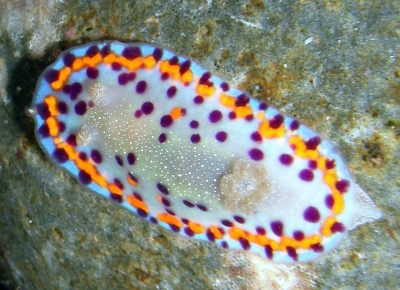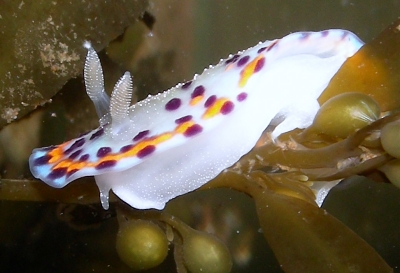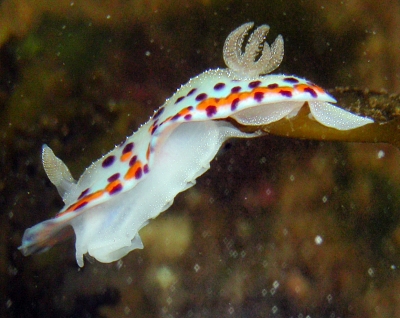Chromodoris naiki from Ratnagiri, India
March 9, 2009
From: Vishal J Bhave.


Concerning message #2760:
It was found in the rock pool with narrow mouth. This is a rocky area with many rockpools with lots of hydroids,sponges and alga.
It looks like Chromodoris naiki but for me it is too confusing to identify from externally.
Locality: Mandavi (Black sea), Ratnagiri, 2 feet, Maharashtra, India, Arabian sea, 23 January 2009, Intertidal, in rockpool. [lat. - 16.9858, long. - 73.2730]. Length: 3 cm. Photographer: Vishal Bhave.
Vishal Bhave
vishalbhave@gmail.com
Bhave, V.J., 2009 (Mar 9) Chromodoris naiki from Ratnagiri, India. [Message in] Sea Slug Forum. Australian Museum, Sydney. Available from http://www.seaslugforum.net/find/22316
Dear Vishal,
This is a valuable addition to our knowledge. When C. naiki was first described, my first thought was its similarity to C. kitae, which I had previously thought was very similar to C. tumulifera. Valdés, Mollo & Ortea (1999), when describing C. naiki also noted its similarity to C. kitae but considered the presence of orange spots in the centre of the mantle as well as in the submarginal band, and the fine white spots, to be chracters distinguishing C. naiki from C. kitae. They also considered that the two species could be distinguished on gill numbers [6 in C. naiki; 8 in C. kitae]. Your animal appears have 7 gills. I have difficulty that the number of gills is so precise in these species.
Your animal also differs from 'typical' C. naiki in having the orange spots mostly confined to a submarginal mantle band. What makes your animal interesting is that it essentially identical to a species described from Bombay [Mumbai] -C. bombayana Winckworth, 1946. The only difference is that he describes the dark purple spots as black. Otherwise he describes the greenish background colour, the fine white spots on the gills, rhinophores and mantle, and the submarginal band of coalescing orange spots. I didn't recognise the similarity between C. naiki and C. bombayana previously because the only specimens known were those in the original description with many orange spots coalescing with the purple spots in the centre of the mantle. if you find further specimens of this species it would be interesting to see more photos so we can get a better idea of its colour variability.
-
Winckworth, H. C. (1946) Glossodoris from Bombay. Proceedings of the Malacological Society of London, 26, 155-160.
Best wishes,
Bill Rudman
Related messages
-
Re: Chromodoris naiki from Ratnagiri, India
From: Vishal Bhave, May 29, 2009 -
Chromodoris naiki from India
From: Ángel Valdés, July 25, 2000
